Print on Demand: Observations and Insights
Ever had a killer t-shirt idea and thought, “Someone would totally wear this”?
Welcome to the world of Print On Demand (POD), where your creativity can turn into a “thriving online business” — without ever needing to touch inventory. LOL, this is the dream, right?
What is Print on Demand?
Print on Demand is a business model that allows you to create and sell custom products without the hassle of managing inventory or shipping. You design the product, and a third-party supplier handles the rest. It’s like having your own store without the overhead costs.
Why Choose Print on Demand?
-
Low Startup Costs: You don’t need to invest in inventory upfront. You only pay for products after you make a sale. Actually, you pay the production cost, upfront before you receive any money from the sale.
-
No Inventory Management: Forget about storing products or dealing with unsold stock. Except when it’s being returned.
-
Flexibility: You can easily test new designs and products without the risk of being stuck with unsold inventory.
-
Global Reach: Sell to customers all over the world without worrying about shipping logistics. Worry about the logistics of returns, though. And VAT/GST.
-
Creative Freedom: Design products that reflect your unique style and brand.
-
Passive Income: Once your store is set up, you can earn money while you sleep. If you can get customers to it. You can set up your store to run on autopilot, with automated order processing and fulfillment. But it also means someone could drain your CC, and cancel the order after production and before shipping.
-
Scalability: As your business grows, you can easily add new products and designs without the need for additional resources.
-
No Shipping Hassles: The POD supplier takes care of shipping, so you can focus on marketing and growing your business.
How to Get Started with Print on Demand
- Choose Your Niche: Find a niche that you’re passionate about and that has a market demand. This could be anything from funny quotes to custom (GenAI) illustrations.
- Select a POD Platform: There are several platforms to choose from, including Printful, Teespring, Printify, Gelato and Redbubble, Teepublic or Threadless. Each has its own features and pricing, so do your research.
- Create Your Designs: Use design software like Canva or Affinity Designer to create eye-catching designs. Remember, the more unique and appealing your designs are, the better your chances of making sales.
- Set Up Your Store: Create an online store using platforms like Printify or Gelato combined with Etsy. Make sure to optimize your store for SEO to attract organic traffic, in as far as you can optimize it. Be prepared to pay for the Plus subscriptions to get extra features.
- Market Your Products: Use social media, email marketing, and paid ads to promote your products. Collaborate with influencers in your niche to reach a wider audience. Else, you won’t see any visitors to your store.
- Analyze and Optimize: Keep track of your sales and customer feedback. Use this data to improve your designs and marketing strategies. Except, you’ll be getting a lot of spam too.
- Scale Your Business: As you start making sales, consider expanding your product range or exploring new niches.
- Stay Updated: The POD industry is constantly evolving, so stay informed about the latest trends and technologies to keep your business competitive. But when watching those YouTube videos, be sceptical…
Etsy vs Teepublic/RedBubble
http://tee.pub/lic/9WM4sbzUCIU
To recap
When a YouTuber says they made $6000 in a week, they mean revenue, the total of goods sold. They also had to advance those $6000 on their credit card to get those goods made, be prepared for that. That also contains a varied % of VAT/GST from around the world (ex. 24% for Norway). They also had to pay for VAT/GST themselfs for the production of those goods. If you’re a very small, one person business, you may not be registered for GST (to get it back). If they sold that much, they would have also spend a fortune on Etsy advertisement, because there is no way to get organic traffic going in such a volume. They also had to pay Etsy listing fees for each item ($0.25), every three months. Pay for Etsy transaction fees on payments (6.5% on item total), Etsy transaction fees on postage (6.5% on postage total, even though Etsy doesn’t ship anything), an Etsy processing fee of 4% of the order total plus $0.25.
In case of Printify, if your Etsy store is set up in AUD, but your Printify account is set to USD, then item prices sent from Printify to Etsy are not converted, they don’t include a currency. So you end up with a $50 USD item in your Etsy store as a $50 AUD item, which should in fact be $80 AUD. And apparently it’s not a bug.
If you sell goods in Norway, your customers will pay 24% Norwegian VAT, which is handled by Etsy (which you pay for). In case of Printify, they also charged me 24% Norwegain VAT on my production order, even though as their customer, I am in Australia, and should only be charged 10% Australian GST. It’s impossible to find any explanation about this on the Printify site. My Norwegian customer came back to me that they had issues with VAT, which they had to pay again. They ended up paying VAT at 80% of the base price of the t-shirt (nearly doubling the original price). Printify collecting my VAT, and not passing on
So while you think you may be offering cheap t-shirts, and you think you can have a low profit margin because you don’t have to worry about stock, think again. Be sure to pad your profit margin because you’ll have to deal with all kinds of additional fees, or you might end up spending money on each order. I did, with my order from Norway. So you end up with overpriced T-Shirts, like everywhere else, having no advantage at all.






